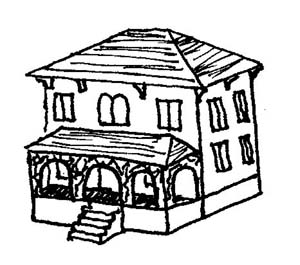Home > Old houses > ItalianateItalianate
The Italianate architecture style is a distinct, 19th-century architectural style. It was derived from Italian Renaissance architecture and was popularized in the United Kingdom, the United States, and Canada. The style was very popular during the Victorian era (1837-1901) and was particularly fashionable from the 1840s to the 1880s. The style is characterized by intricately detailed and elaborate arches and doorways, ornamental window casements and gables, low-hipped roofs with wide eaves and decorative verge boards, stone quoins, and grand, columned porticoes with Corinthian capitals.
The main aim of an Italianate style was to evoke a sense of grandeur and to reflect the grandeur of the Italian Renaissance. These properties were often used to evoke grandeur in theater, hotels, courthouses, and churches. Italianate architecture is associated with wealth and prosperity, as it was often used by well-to-do people. The Italianate style draws its influence from a range of Italian architectural sources. It was inspired by the classical styles of architecture found in Florence and Venice. The style often includes elements of Palladian, Baroque, or Neo-Classical architectural styles, as well as features such as Tuscan pilasters, pediments, arched or segmented windows, and cupolas.
The properties of Italianate architecture have distinct features that are carried across the style wherever it is found, such as the use of symmetrical shapes, curved windows, and gables, as well as the use of bold colors and finishes to brighten the property’s exterior. Furthermore, the Italianate house is usually constructed of brick or stucco, and most commonly, will feature two floors. Open porches and balconies are often added to Italianate house façades, emphasizing the style’s verticality. A columned front porch may be decorated with arched openings, cast iron balcony railings and columns, ornamental brackets, intricate cornices, and decorative friezes. Although the style changed over time, during its heyday in the 1840s and 80s, the Italianate style was one of the most popular architectural styles in North America.
The style was particularly popular in urban areas. In larger cities, it was used to build grand mansions, townhouses, public buildings, and other structures. The style was adapted to smaller rural towns and cities, often taking the form of smaller houses or cottages. Usually, these properties had a symmetrical floor plan, a verandah, bay windows, and a hipped roof.
Italianate architecture enjoys a longstanding popularity and can be seen in many older towns and cities in the United States, Canada, and the UK. The Italianate style has influenced many contemporary architectural designs, and can be seen in many new buildings to this day. Italianate is a decorative style of architecture that developed in Italy during the Renaissance, and subsequently spread throughout Europe and North America. It is characterized by ornate facades and classical motifs inspired by Italian Renaissance architecture. Italianate architecture enjoyed its first heyday in the early 19th century and was particularly common in the mid-Victorian era.
In Italianate architecture, the overall effect is one of symmetry and proportion, with the aim of producing a visually pleasing and harmonious aesthetic. Its style is distinguished by tall and horizontal massing, low-pitched roofs, wide eaves, and brackets and corbels under windows and eaves. Roof lines are often topped with balustrades, cupolas, or towerlike forms, and wide chimneys typically display a cobblestone base and urn-shaped chimney tops. The exterior walls of an Italianate house are generally composed of two elements: a base, which forms the lowest and strongest part of the wall, and a finish, which is an ornamental element that adds visual interest and decorative detail. The base is typically constructed of brick, stone, or stucco, and the finish is most often composed of wooden shutters, decorative quoins, window surrounds, architraves, pediments, and simulated columns.
Italianate architecture often features tall windows, which typically have rounded or segmented arches and are placed at regular intervals along the facade. Windows often have double- hung shutters, and are typically topped by heavy stone lintels or an ornamental arch. The window openings are generally topped with decorative keystones, and may be further decorated with decorative surrounds, such as tile, stone, wood, or ironwork. The most recognizable feature of Italianate style is the entrance door. In residential architecture, the entrance is usually framed with an elaborate portico of arches and columns. The doorway may also be topped with a pediment or arch. Other common features include arched windows, decorative friezes, balustrades, and wrought iron railing.
The interior of a typical Italianate home differs from region to region, but can generally be described as refined and luxurious. Common interior features include ornate plasterwork ceilings, molded cornices, architraves, and paneled walls. Fireplaces are often richly embellished with elaborate mantels, marble facings, and bronze or wrought iron fixtures. Staircases may feature ornamental balustrades, and rooms often feature pocket doors and a variety of molded details, such as crown molding, dentil work, oak or walnut trim, and inlaid floors.
The use of color is also important in Italianate architecture. Soft pastels in shades of yellow, green, blue, and pink are often used to brighten interior spaces, while deep colors, such as red and brown, tend to be used as accent colors. Wall surfaces are typically finished with an embossed or stenciled paint technique to give the walls a unique appearance.
Italianate style can be identified by its unique fusion of form and decorative detail. Its strong horizontal and vertical massing, asymmetrical façade, and eclectic mix of classical elements, all combine to create an aesthetically pleasing and unique expression. It is one of the most enduring and beloved architectural styles of the 19th century, enjoyed by many homeowners today.










